Quantifying the Effect of Land Use Change and Climate Variability on Green Water Resources in the Xihe River Basin, Northeast China
Abstract
1. Introduction
2. Material and Methods
2.1. Research Area Overview
2.2. Data Sources
2.3. Methodology and Process
2.3.1. SWAT Model
2.3.2. Water Resource Statistics
2.3.3. Design of Simulation Scenarios
2.3.4. Simulation
3. Results and Analysis
3.1. Analysis of Land Use Change
3.2. Simulation Results of SWAT
3.3. Effects of Climate Variability and Land Use Change on Green Water Resources
3.3.1. Changes of Green Water Flow
3.3.2. Changes of Green Water Storage
3.3.3. Changes of Green Water Coefficient
4. Discussion
5. Conclusions
Author Contributions
Funding
Conflicts of Interest
References
- Falkenmark, M. Land and Water Integration and River Basin Management; FAO: Rome, Italy, 1995. [Google Scholar]
- WU, H.T. Research on Assessment and Management of Green Water. China Popul. Resour. Environ. 2008, 18, 61–67. [Google Scholar] [CrossRef]
- Liu, J.G.; Zehnder, A.J.B.; Hong, Y. Global consumptive water use for crop production: The importance of green water and virtual water. Water Resour. Res. 2009, 45, 641–648. [Google Scholar] [CrossRef]
- Wang, J.P.; Ma, J.Z.; Afton, C.S.; Qu, J.S. Estimating Changes in the Green Water Productivity of Cropping Systems in Northern Shaanxi Province in China’s Loess Plateau. Water 2018, 10, 1198. [Google Scholar] [CrossRef]
- Zahabiyoun, B.; Goodarzi, M.R.; Bavani, A.R.M.; Azamathulla, H.M. Assessment of climate change impact on the Gharesou River Basin using swat hydrological model. CLEAN Soil Air Water 2013, 41, 601–609. [Google Scholar] [CrossRef]
- Liang, J.G.; Ding, S.Y. The Impacts of Climate and Landuse Changes on The Runoff Effects: Case in The Upper Reaches of The Yihe River, The Yiluo River Basin. Sci. Geogr. Sin. 2012, 32, 635–640. [Google Scholar] [CrossRef]
- Zhou, F.; Xu, Y.; Chen, Y.; Xu, C.Y.; Gao, Y.; Du, J. Hydrological re-response to urbanization at different spatio-temporal scales simulated by coupling of clue-s and the swat model. J. Hydrol. 2013, 485, 113–125. [Google Scholar] [CrossRef]
- Cheng, G.D.; Zhao, W.Z. Green water and Its Research Progresses. Adv. Earth Sci. 2016, 21, 221–227. [Google Scholar] [CrossRef]
- Zhao, A.Z.; Zhu, X.F.; Pan, Y.Z.; Liu, X. Spatiotemporal Variation of Blue-Green Water under Typical Reference Years in the Weihe River Basin. China. J. Agrometeorol. 2016, 37, 149–157. [Google Scholar] [CrossRef]
- Faramarzi, M.; Abbaspour, K.C.; Schulin, R.; Yang, H. Modelling blue and green water resources availability in Iran. Hydrol. Process. 2009, 23, 486–501. [Google Scholar] [CrossRef]
- Schuol, J.; Abbaspour, K.C.; Yang, H.; Srinivasan, R.; Zehnder, A.J.B. Modeling blue and green water availability in Africa. Water Resour. Res. 2008, 44, 212–221. [Google Scholar] [CrossRef]
- XU, Z.X.; Zuo, D.P. Scientific assessment of water resources with broaden thoughts: A case study on the blue and green water resources in the Wei River Basin. South-to-North Water Transf. Water Sci. Technol. 2013, 11, 12–16. [Google Scholar] [CrossRef]
- Zhao, A.Z.; Zhu, X.F.; Liu, X.F.; Pan, Y.Z.; Zuo, D.P. Impacts of land use change and climate variability on green and blue water resources in the Weihe River Basin of northwest China. Catena 2016, 137, 318–327. [Google Scholar] [CrossRef]
- Zhu, K.; Xie, Z.B.; Zhao, Y.; Lu, F.; Song, X.Y.; Li, L.; Song, X.M. The Assessment of Green Water Based on the SWAT Model: A Case Study in the Hai River Basin, China. Water 2018, 10, 798. [Google Scholar] [CrossRef]
- Wei, X.; Declan, C.; Lin, E.; Xu, Y.L.; Hui, J.; Jiang, J.H. Future cereal production in china: The interaction of climate change, water availability and socio-economic scenarios. Glob. Environ. Chang. 2009, 19, 34–44. [Google Scholar] [CrossRef]
- Zuo, D.; Xu, Z.; Peng, D.; Song, J.; Cheng, L.; Wei, S. Simulating spatiotemporal variability of blue and green water resources availability with uncertainty analysis. Hydrol. Process. 2015, 29, 1942–1955. [Google Scholar] [CrossRef]
- Moriasi, D.N.; Arnold, J.G.; Liew, M.W.V.; Bingner, R.L.; Harmel, R.D.; Veith, T.L. Model evaluation guidelines for systematic quantification of accuracy in watershed simulations. Trans. Asabe 2007, 50, 885–900. [Google Scholar] [CrossRef]
- Pan, D.; Ren, L. Application of Distributed Hydrological Model in Irrigation Management of Tuhai-Majia River Basin, I. Parameter Calibration Valid. 2012, 45, 471–479. [Google Scholar] [CrossRef]
- Lv, L.T.; Peng, Q.Z.; Guo, Y.Y.; Liu, Y.H.; Jiang, Y. Runoff simulation of Dongjiang River Basin based on the soil and water assessment tool. J. Nat. Resour. 2014, 29, 1746–1757. [Google Scholar] [CrossRef]
- Zang, C.F. Assessment of Spatial and Temporal Variability of Green and Blue Water Flows in the Heihe River Basin, China; Beijing Forestry University: Beijing, China, 2013. [Google Scholar]
- Zang, C.F.; Liu, J.G. Spatial and Temporal Variability of Blue-Green Water Flows in Typical Reference years in the Heihe River Basin, Northwestern China. J. Beijing For. Univ. 2013. [Google Scholar] [CrossRef]
- XU, J.X. Increasing trend of green water coefficient in the middle yellow river basin and the eco-environmental implications. Acta Ecol. Sin. 2015, 127, 562–572. [Google Scholar] [CrossRef]
- Ye, X.C.; Zhang, Q.; Liu, J. Impact of climate change and human activities on runoff of Poyang Lake catchment. J. Glaciol. Geocryol. 2009, 31, 835–842. [Google Scholar] [CrossRef]
- Feng, X.Q.; Zhang, G.X.; Yin, X.Y. Study on the hydrological response to climate change in Wuyur River Basin based on the swat model. Prog. Geogr. 2010, 29, 827–832. [Google Scholar] [CrossRef]
- Khoi, D.N.; Suetsugi, T. The responses of hydrological processes and sediment yield to land-use and climate change in the be river catchment, Vietnam. Hydrol. Process. 2014, 28, 640–652. [Google Scholar] [CrossRef]
- Wang, G.; Yang, H.; Wang, L.; Xu, Z.; Xue, B. Using the swat model to assess impacts of land use changes on runoff generation in headwaters. Hydrol. Process. 2014, 28, 1032–1042. [Google Scholar] [CrossRef]
- Fohrer, N.; Haverkamp, S.; Frede, H.G. Assessment of the effects of land use patterns on hydrologic landscape functions: Development of sustainable land use concepts for low mountain range areas. Hydrol. Process. 2005, 19, 659–672. [Google Scholar] [CrossRef]
- Senent-Aparicio, J.; Liu, S.; Pérez-Sánchez, J.; López-Ballesteros, A.; Jimeno-Sáez, P. Assessing Impacts of Climate Variability and Reforestation Activities on Water Resources in the Headwaters of the Segura River Basin (SE Spain). Sustainability 2018, 10, 3277. [Google Scholar] [CrossRef]
- Glavan, M.M.; Pintar, M.; Volk, M. Land use change in a 200-year period and its effect on blue and green water flow in two Slovenian Mediterranean catchments-lessons for the future. Hydrol. Process. 2013, 27, 3964–3980. [Google Scholar] [CrossRef]
- Douglas, E.M.; Niyogi, D.; Frolking, S.; Yeluripati, J.B.; Sr, R.A.P.; Niyogi, N.C.J.; Vorosmarty, U.C. Changes in moisture and energy fluxes due to agricultural land use and irrigation in the Indian monsoon belt. Geophys. Res. Lett. 2006, 33, 70–84. [Google Scholar] [CrossRef]
- Gordon, L.J.; Steffen, W.; Jönsson, B.F.; Folke, C.; Falkenmark, M.; Johannessen, Å. Human modification of global water vapor flows from the land surface. Proc. Natl. Acad. Sci. USA 2005, 102, 7612–7617. [Google Scholar] [CrossRef]
- Biggs, T.W.; Scott, C.A.; Gaur, A.; Venot, J.; Chase, T.; Lee, E. Impacts of irrigation and anthropogenic aerosols on the water balance, heat fluxes, and surface temperature in a river basin. Water Resour. Res. 2008, 44. [Google Scholar] [CrossRef]
- Jackson, R.B.; Carpenter, S.R.; Dahm, C.N.; Mcknight, D.M.; Naiman, R.J.; Postel, S.L.; Running, S.W. Water in a changing world. Ecol. Appl. 2001, 11, 1027–1045. [Google Scholar] [CrossRef]
- Zhu, Z.R.; Guo, S.S. Variation characteristics of precipitation and rainfall intensity with different grades in the Xihe River Basin. J. Liaoning Norm. Univ. 2017, 40, 370–386. [Google Scholar] [CrossRef]
- Hao, X.; Chen, Y.; Xu, C.; Li, W. Impacts of climate change and human activities on the surface runoff in the Tarim River Basin over the last fifty years. Water Resour. Manag. 2008, 22, 1159–1171. [Google Scholar] [CrossRef]
- Ren, L.; Wang, M.; Li, C.; Zhang, W. Impacts of human activity on river runoff in the northern area of china. J. Hydrol. 2002, 261, 204–217. [Google Scholar] [CrossRef]
- Buytaert, W.; Célleri, R.; Bièvre, B.D.; Cisneros, F.; Wyseure, G.; Deckers, J. Human impact on the hydrology of the Andean Páramos. Earth Sci. Rev. 2006, 79, 53–72. [Google Scholar] [CrossRef]
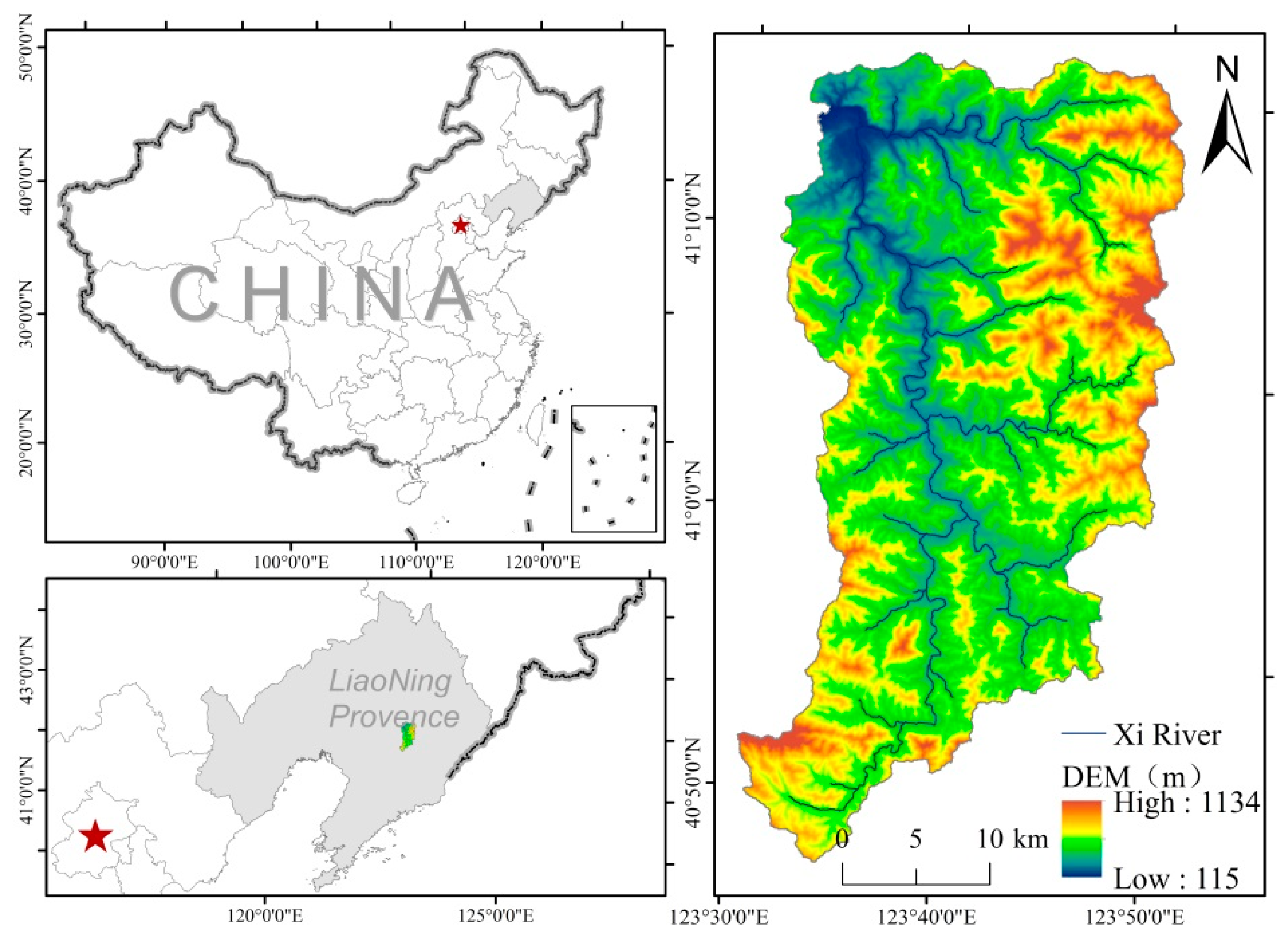
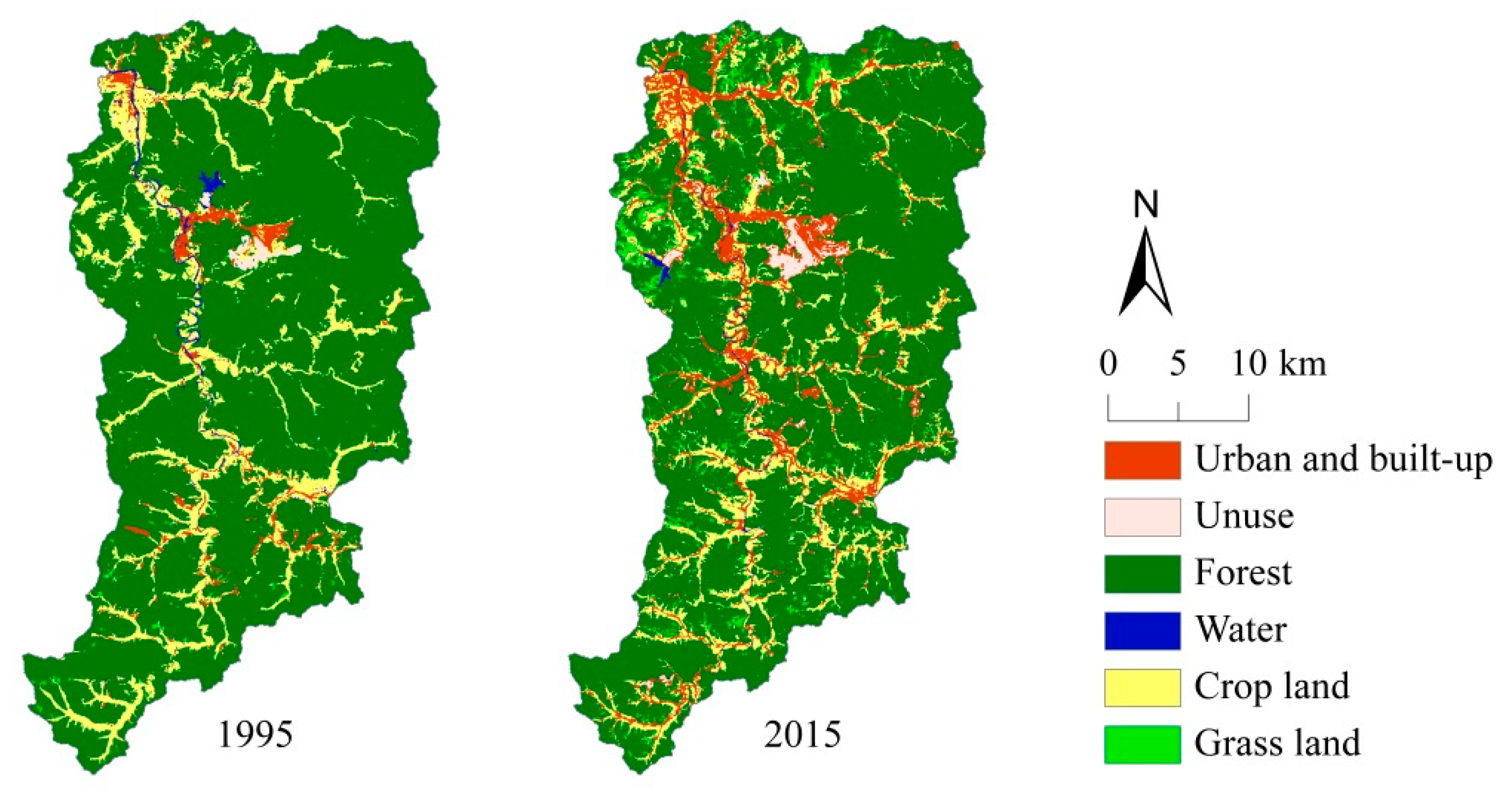
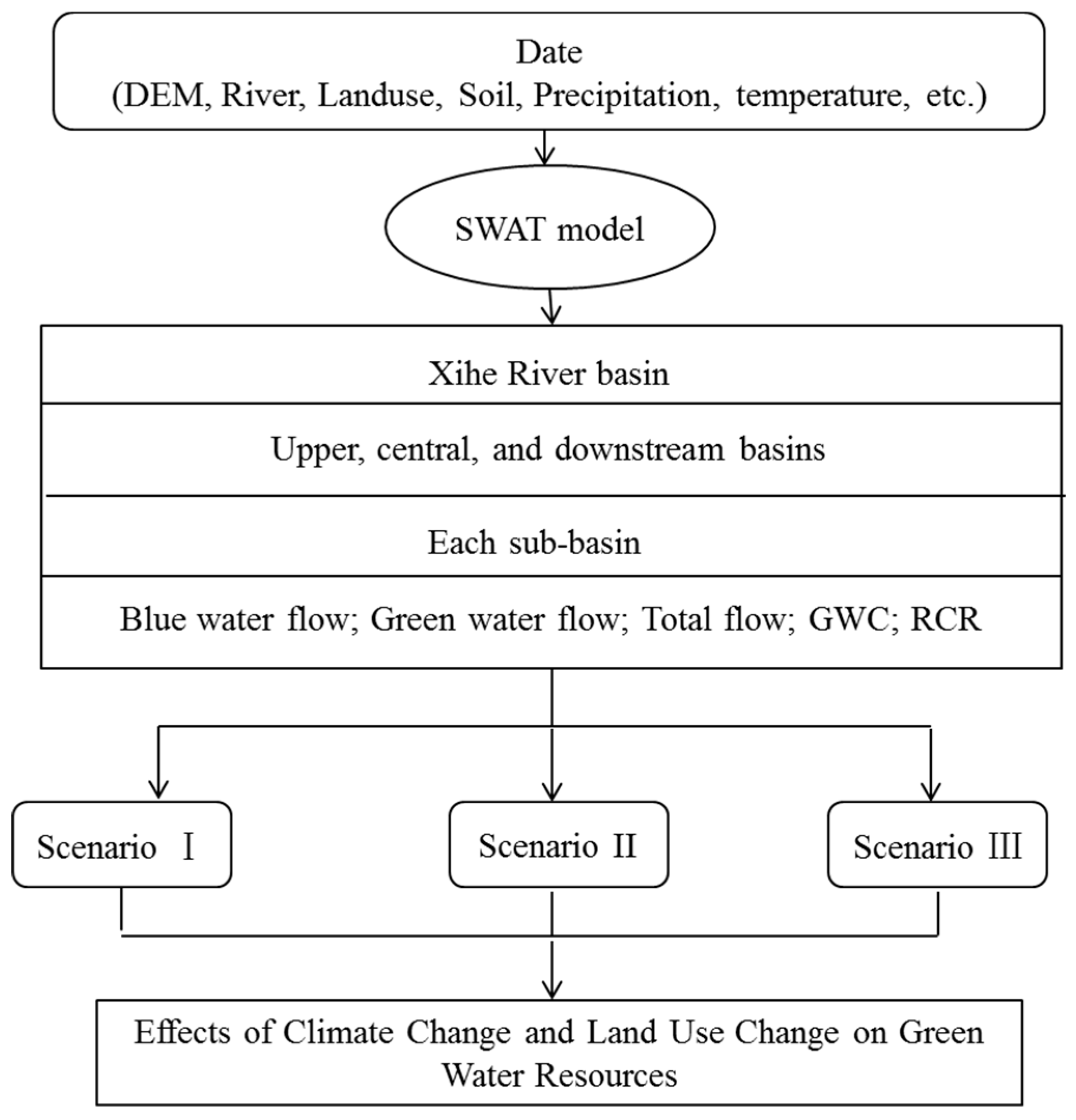
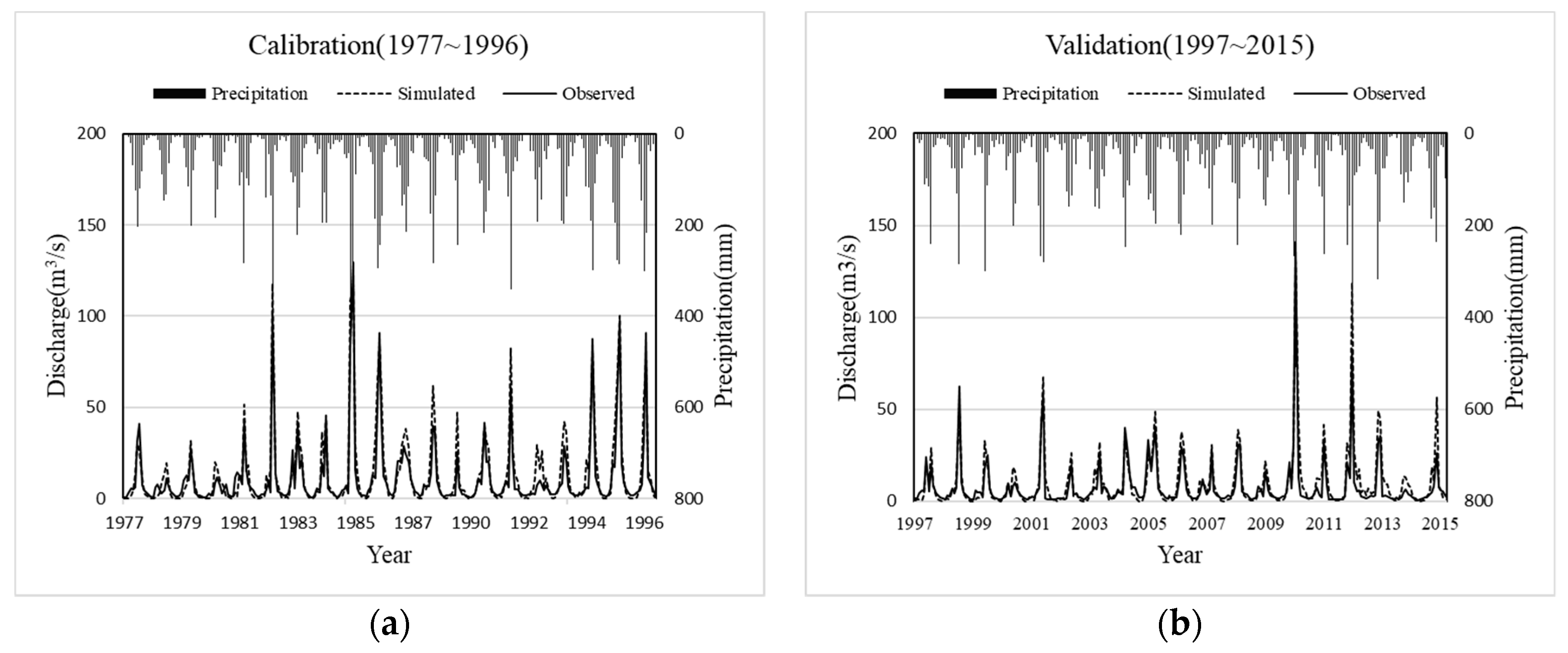
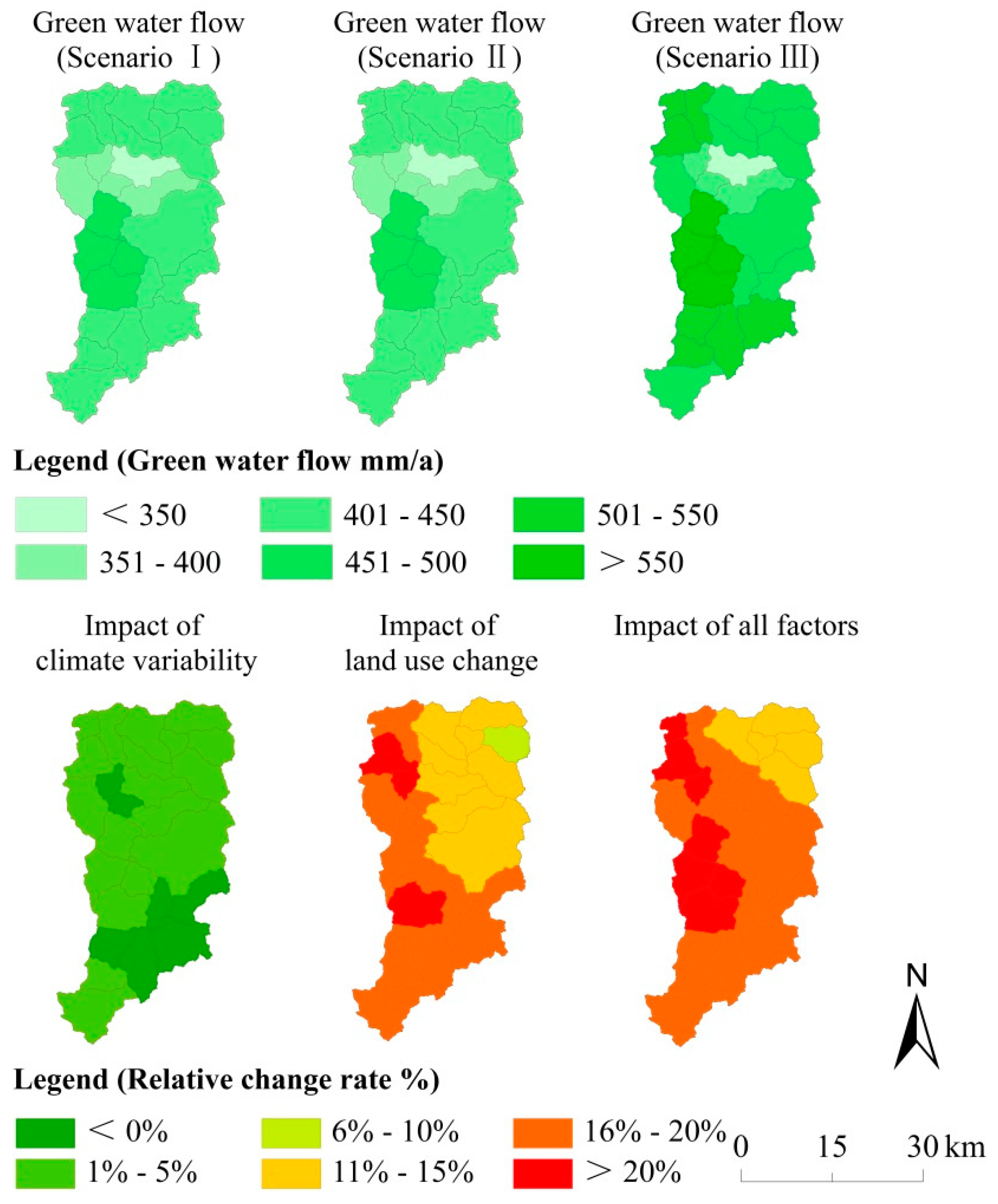
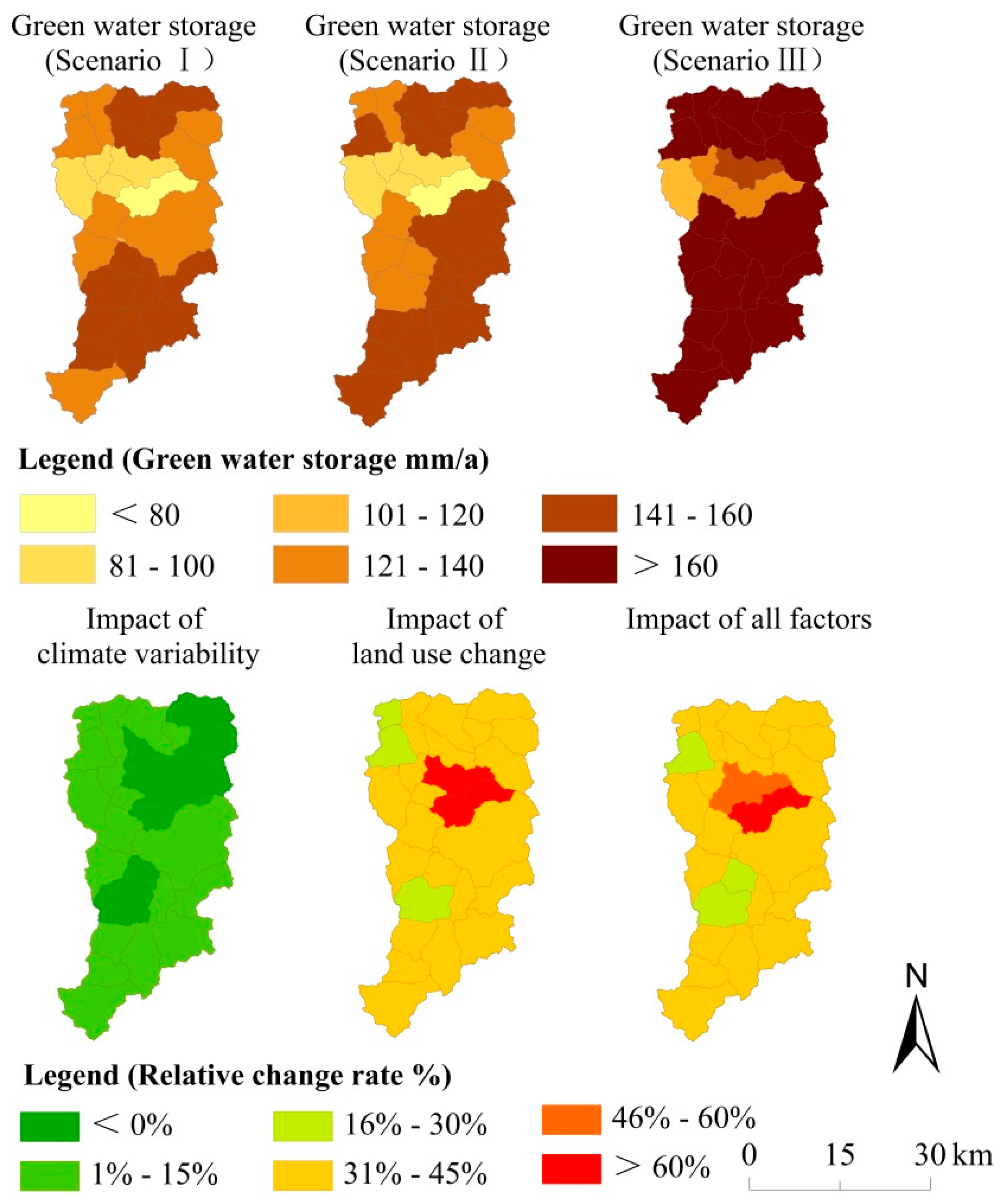
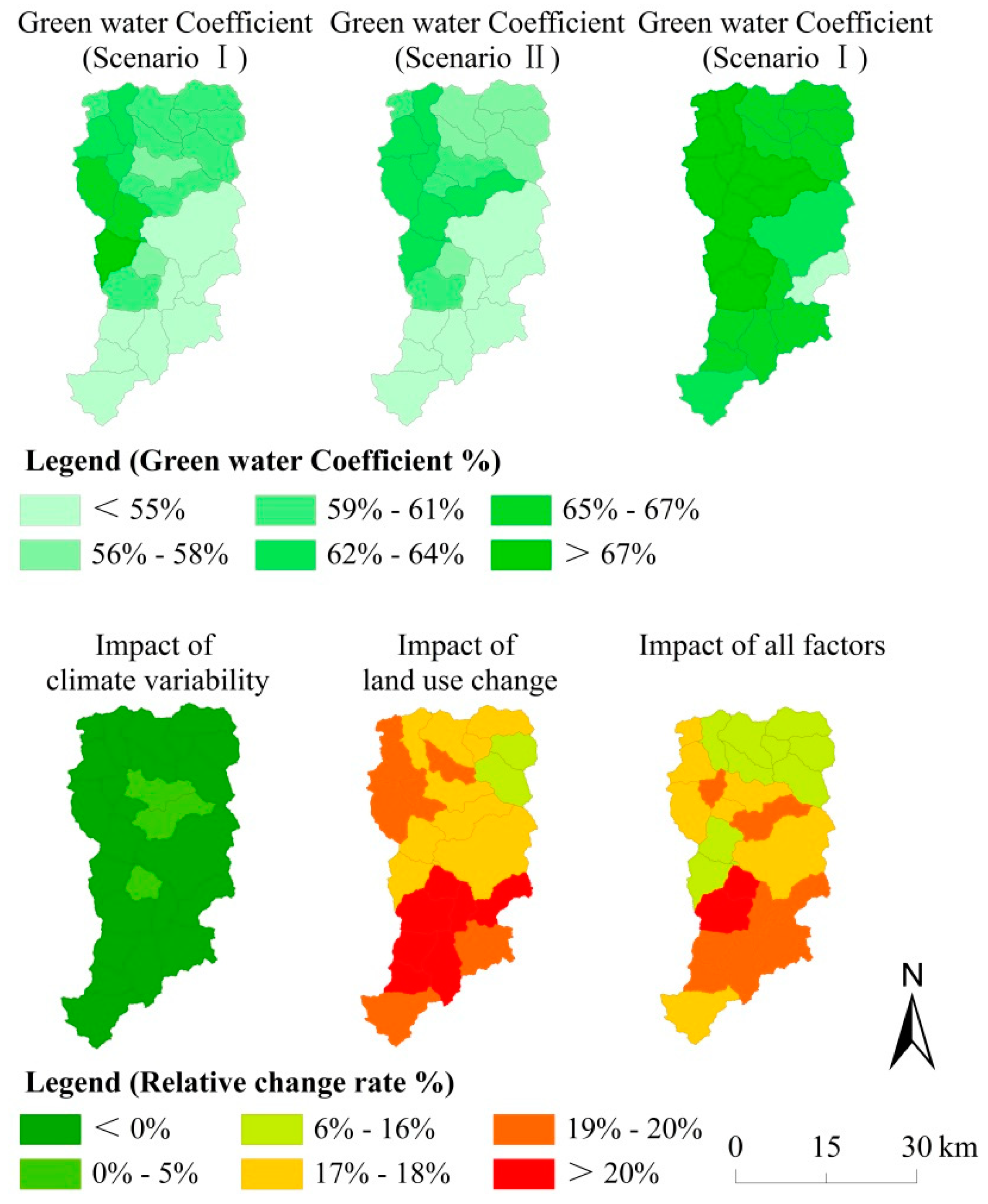
| Station | Data | Longitude | Latitude |
|---|---|---|---|
| Gujiatun | daily precipitation | 124°16′20″ | 41°37′35″ |
| Nanfen | daily precipitation | 124°15′18″ | 41°09′00″ |
| Xiamatang | daily precipitation | 124°13′33″ | 41°03′33″ |
| Yongziyu | daily precipitation | 124°30′15″ | 41°15′60″ |
| Qiaotou | daily precipitation and runoff | 124°10′10″ | 41°22′26″ |
| Benxi | daily precipitation, temperature, solar radiation, wind speed, and relative humidity | 124°43′06″ | 42°39′41″ |
| Year | Class | Number of Reference Pixels | Number of Pixels Classified | Number of Pixels Classified Correctly | Product Accuracy (%) | User Accuracy (%) |
|---|---|---|---|---|---|---|
| 1995 | Water | 168 | 171 | 167 | 99.40 | 97.66 |
| Urban and built-up | 98 | 94 | 93 | 94.90 | 98.94 | |
| Forest | 357 | 375 | 357 | 100.00 | 95.20 | |
| Unuse | 52 | 55 | 46 | 88.46 | 83.64 | |
| Grass land | 46 | 30 | 30 | 65.22 | 100.00 | |
| Crop land | 272 | 268 | 263 | 96.69 | 98.13 | |
| Total | 993 | 993 | 956 | |||
| Overall Accuracy = 96.27% Kappa Coefficient = 0.9502 | ||||||
| 2015 | Water | 61 | 58 | 57 | 93.44 | 98.28 |
| Urban and built-up | 131 | 146 | 112 | 85.50 | 76.71 | |
| Forest | 291 | 277 | 274 | 94.16 | 98.92 | |
| Unuse | 104 | 134 | 102 | 98.08 | 76.12 | |
| Grass land | 103 | 62 | 49 | 47.57 | 79.03 | |
| Crop land | 141 | 154 | 141 | 100.00 | 91.56 | |
| Total | 831 | 831 | 735 | |||
| Overall Accuracy = 88.45% Kappa Coefficient = 0.8537 | ||||||
| Scenario | Land Use | Meteorological Data |
|---|---|---|
| Scenario I | 1995 | 1990–1999 |
| Scenario II | 1995 | 2006–2015 |
| Scenario III | 2015 | 2006–2015 |
| Periods | Land Use Change | Forest | Cropland | Urban and Built-up | Water | Unused | Grassland |
|---|---|---|---|---|---|---|---|
| 1995 | Area (km2) | 913.35 | 147.01 | 30.06 | 8.89 | 8.88 | 3.28 |
| Percent (%) | 82.17 | 13.23 | 2.70 | 0.80 | 0.80 | 0.30 | |
| 2015 | Area (km2) | 806.82 | 144.26 | 103.11 | 5.43 | 16.60 | 35.25 |
| Percent (%) | 72.59 | 12.98 | 9.28 | 0.49 | 1.49 | 3.17 | |
| 1995–2015 | Change area (km2) | −106.53 | −2.75 | 73.05 | −3.46 | 7.72 | 31.97 |
| Change percent (%) | −9.58 | −0.25 | 6.57 | −0.31 | 0.69 | 2.88 |
© 2019 by the authors. Licensee MDPI, Basel, Switzerland. This article is an open access article distributed under the terms and conditions of the Creative Commons Attribution (CC BY) license (http://creativecommons.org/licenses/by/4.0/).
Share and Cite
Lyu, L.; Wang, X.; Sun, C.; Ren, T.; Zheng, D. Quantifying the Effect of Land Use Change and Climate Variability on Green Water Resources in the Xihe River Basin, Northeast China. Sustainability 2019, 11, 338. https://doi.org/10.3390/su11020338
Lyu L, Wang X, Sun C, Ren T, Zheng D. Quantifying the Effect of Land Use Change and Climate Variability on Green Water Resources in the Xihe River Basin, Northeast China. Sustainability. 2019; 11(2):338. https://doi.org/10.3390/su11020338
Chicago/Turabian StyleLyu, Leting, Xiaorui Wang, Caizhi Sun, Tiantian Ren, and Defeng Zheng. 2019. "Quantifying the Effect of Land Use Change and Climate Variability on Green Water Resources in the Xihe River Basin, Northeast China" Sustainability 11, no. 2: 338. https://doi.org/10.3390/su11020338
APA StyleLyu, L., Wang, X., Sun, C., Ren, T., & Zheng, D. (2019). Quantifying the Effect of Land Use Change and Climate Variability on Green Water Resources in the Xihe River Basin, Northeast China. Sustainability, 11(2), 338. https://doi.org/10.3390/su11020338





